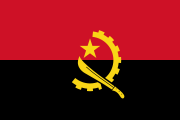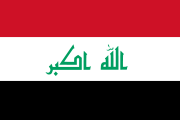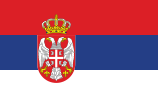Strela 2
| 9K32 Strela-2 NATO reporting name: SA-7 Grail |
|
|---|---|
 KBM Kolomna 9K32 Strela-2 missile and canister |
|
| Type | Man portable surface-to-air missile launcher |
| Place of origin | |
| Service history | |
| In service | 1968- present |
| Used by | See Operators |
| Production history | |
| Designer | KBM (Kolomna) |
| Designed | 1964 approx |
| Variants | See versions |
| Specifications | |
| Weight | 9.8 kg (Strela-2M missile)[1] 15 kg (system, ready to fire)[1] |
| Length | 1.44 m[1] |
| Diameter | 72 mm[1] |
|
|
|
| Maximum range | 3700m (Strela-2) 4200m (Strela-2M)[1] |
| Warhead weight | 1.15kg directed-energy blast fragmentation warhead (Strela-2M),[1] 370g HE content. |
| Detonation mechanism |
non-delay impact and grazing fuzes, 14–17 second delay self-destruct. |
|
|
|
| Wingspan | 0.3 m |
| Flight altitude | 50–1500 m (Strela-2) 50–2300m (Strela-2M)[1] |
| Speed | 430m/s (Strela-2) 500m/s (Strela-2M)[2] |
| Guidance system |
Proportional navigation logic |
-
- For the STRELA computer, see Strela computer.
- For the Apollo test mission see A-102 (SA-7)
The 9K32 “Strela-2” (Russian 9К32 “Cтрела-2” — arrow; NATO reporting name SA-7 Grail) is a man-portable, shoulder-fired, low-altitude surface-to-air missile system with a high explosive warhead and passive infrared homing guidance. Broadly comparable to the US Army FIM-43 Redeye, it was the first generation of Soviet man portable SAMs, entering service in 1968, with series production starting in 1970.[3]
Described by one expert as being "the premier Russian export line",[4] the Strela and its variants have seen widespread use in nearly every regional conflict since 1968.
Contents |
Development
The end of World War II saw a major shift in Soviet defense policy. The advent of long range, high altitude, nuclear-armed American bombers, capable of penetrating Soviet airspace at heights and speeds unreachable and unmatchable by all existing anti-aircraft guns and most interceptors, at a stroke appeared to render every conventional weapon obsolete. To counter this large vulnerability, numerous long-range, high-altitude SAM systems, such as the SA-1 "Guild" and SA-2 "Guideline", were rapidly developed and fielded, but due to the apparent 'obsolescence' of conventional arms, relatively little development took place to field mobile battlefield air defenses.
This direction was soon to change, however, with the beginning of the Korean war. An entirely conventional conflict, it proved that nuclear weapons were not the be all and end all of warfare. In the face of a powerful and modern American air force, carrying non-nuclear payloads, the Soviet Union invested heavily in a multi-tier air defense system, consisting of several new mobile SAMs, to cover all altitude ranges and protect ground forces. The new doctrine listed 5 requirements:
- Front-level medium to high altitude area defense system 9K8 Krug (NATO designation SA-4 “Ganef”)
- Army-level low to medium-range area defense system 3K9 Kub (NATO designation SA-6 “Gainful”)
- Division-level low altitude short-range system 9K33 Osa (NATO designation SA-8 “Gecko”)
- Regiment-level all-weather radar-guided gun system ZSU-23-4 “Shilka” and very short range missile systems Strela-1 (NATO designation SA-9 "Gaskin")
- Battalion-level man-portable Strela-2 (NATO SA-7 “Grail”)

Both Strela-1 and Strela-2 were initially intended to be man-portable systems. However, as the Strela-2 proved to be a considerably smaller and lighter package, the role of the Strela-1 was changed, becoming a heavier, vehicle-mounted system with increased range and performance, to better support the ZSU-23-4 in the regimental air defense role.
As development began in the Turopov OKB (later changed to Kolomna), detailed information on the design of the US FIM-43 Redeye became available. The Soviets purportedly acquired the Redeye when one impacted a Mig in-flight during combat operations in Vietnam. The missile failed to detonate and became lodged in the fuselage. While it was by no means a simple reverse-engineered copy, in many ways the Strela design borrowed heavily from the Redeye, which had started development a few years earlier. Due to the comparatively primitive Soviet technical base, development was protracted, and many problems arose, especially in designing a sufficiently small seeker head and rocket. Eventually the designers settled for a simpler seeker head than that of the Redeye, allowing the initial version, the 9K32 “Strela-2” (US DoD designation SA-7A, missile round 9M32) to finally enter service in 1968, five years behind schedule.
Improvements
The initial variant suffered from numerous shortcomings: it could only engage targets flying at relatively slow airspeeds and low altitudes and then only from rear hemisphere, it suffered from poor guidance reliability (particularly in the presence of natural or man-made background IR radiation sources), and even when a hit was achieved, it often failed to destroy the target.[5][6] Poor lethality was an issue especially when used against jet aircraft: the hottest part of the target was the nozzle behind the actual engine, which the missile therefore usually hit - but there its small warhead often failed to cause significant damage to the engine itself.
In order to address the shortcomings, two improved versions were ordered already in 1968; as an intermediate stop-gap the slightly improved 9K32M “Strela-2M” (NATO reporting name SA-7b) to replace the original, as well as the more ambitious Strela-3.
As the modifications introduced with the Strela-2M were relatively minor, the process was fast and it was accepted in service already in 1970.[6] The Strela-2M replaced Strela-2 in production lines immediately. Improvements were made particularly to increase the engagement envelope of the new system:[5]
- higher thrust propellant increased slant range from 3.4 to 4.2 km and ceiling from 1.5 to 2.3 km
- improved guidance and control logic allowed the engagement of propeller-driven and helicopter aircraft (but not jets) approaching at a maximum speed of 150 m/s
- maximum speed of receding targets was increased from 220 m/s to 260 m/s
- more automated gripstock provided a simplified firing method against fast targets: a single trigger pull followed by lead and superelevation replacing the separate stages of releasing the seeker to track, and launching the missile (see Description below)
Contrary to what was at first reported in some western publications, more recent information indicates that while lethality on impact had proven to be a problem, the warhead remained the same 1.17 kg unit (including 370 gram TNT charge) as in the original.[7] This in fact remained the warhead of all Soviet MANPADS up to and including most Igla variants; to address the problem of poor lethality, a more powerful HE filling than TNT, improved fuzing, a terminal maneuver, and finally a separate charge to set off any remaining rocket fuel were gradually introduced in later MANPADS systems, but the original Strela-2/2M warhead design of 370g directed-energy HE charge in a pre-fragmented casing remained.
The seeker head improvements were only minor changes to allow better discrimination of the target signal against background emissions.[5][7] Some sources claim that the seeker sensitivity was also improved.[6] The only defence against infra-red countermeasures remained the seeker head's narrow field of view, which could be hoped to help the rapidly slowing flare fall off the missile field of view as it was tracking a fast-moving target.[5] In practice, flares proved to be highly effective countermeasure against both versions of the Strela-2.
The seeker is commonly referred to as a hot metal tracker. The seeker can only see infrared energy in the near infrared (NIR) spectrum, emitted by very hot surfaces only seen on the inside of the jet nozzle. This obviously allows only rear-aspect engagement of jet targets, earning the weapon its other moniker as a Revenge weapon, since the missile has to "chase" an aircraft after it has already passed by.
The Strela-2M was also procured for use on-board Warsaw Pact warships;[8] installed on four round pedestal mounts[8] aboard Soviet amphibious warfare vessels and various smaller combatants, the weapon remained unchanged, but was assigned the NATO reporting name SA-N-5 'Grail'.[8]
Description
The missile launcher system consists of the green missile launch tube containing the missile, a grip stock and a cylindrical thermal battery. The launch tube is reloadable at depot, but missile rounds are delivered to fire units in their launch tubes. The device can be reloaded up to five times.[9]
When engaging slow or straight-receding targets, the operator tracks the target with the iron sights in the launch tube and applies half-trigger. This action "uncages" the seeker and allows it attempt to track. If target IR signature can be tracked against the background present, this is indicated by green light and buzzer sound. The shooter then pulls the trigger fully, and immediately applies lead and superelevation. This method is called a manual engagement. An automatic mode, which is used against fast targets, allows the shooter to fully depress the trigger in one pull followed by immediate lead and superelevation of the launch tube. The seeker will uncage and will automatically launch the missile if a strong enough signal is detected.
Manufacturer lists reaction time measured from carrying position (missile carried at soldier's back with protective covers) to missile launch to be 13 seconds, a figure that is achievable but requires considerable training and skill in missile handling. With launcher on the shoulder, covers removed and sights extended, reaction time from fire command to launch reduces to 6–10 seconds, depending greatly on target difficulty and shooter's skill.
After activating the power supply to the missile electronics, the gunner waits for electricity supply and gyros to stabilize, puts the sights on target and tracks it smoothly with the launch tube's iron sights, and pulls the trigger on the grip stock. This activates the seeker electronics and the missile attempts to lock onto the target. If the target is producing a strong enough signal and the angular tracking rate is within acceptable launch parameters, the missile alerts the gunner that the target is locked on by illuminating a red light in the sight mechanism, and producing a constant buzzing noise. The operator then has 0.8 seconds to provide lead to the target while the missiles on-board power supply is activated and the throw-out motor ignited.
Should the target be outside acceptable parameters then the light cue in the sight and buzzer signal tell the gunner to re-aim the missile.
On launch, the booster burns out before the missile leaves the launch tube at 32 m/s, and rotating the missile at approximately 20 revolutions per second. As the missile leaves the tube the two forward steering fins unfold, as do the four rear stabilizing tail fins. The self-destruct mechanism is then armed, which is set to destroy the missile after between 14 and 17 seconds to prevent it hitting the ground if it should miss the target.
Once the missile is five and half meters away from the gunner, approximately 0.3 seconds after leaving the launch tube it activates the rocket sustainer motor. The sustainer motor takes it to a velocity of 430 meters per second, and sustains it at this speed. Once it reaches peak speed at a distance of around 120 meters from the gunner, the final safety mechanism is disabled and the missile is fully armed. All told, the booster burns for 0.5 second and the driving engine for another 2.0 seconds.[9]
The missile's uncooled lead sulphide passive infra-red seeker head detects infrared radiation at below 2.8 μm in wavelength. It has a 1.9 degree field of view and can track at 9 degrees per second. The seeker head tracks the target with an amplitude-modulated spinning reticle (spin-scan or AM tracking), which attempts to keep the seeker constantly pointed towards the target. The spinning reticle measures the amount of incoming infrared (IR) energy. It does this by using a circular pattern that has solid portions and slats that allow the IR energy to pass through to the seeker. As the reticle spins IR energy passes through the open portions of the reticle. Based on where the IR energy falls on the reticle the amount or amplitude of IR energy allowed through to the seeker increases the closer to the center of the reticle. Therefore, the seekers is able to identify where the center of the IR energy is. If the seeker detects a decrease in the amplitude of the IR energy it steers the missile back towards where the IR energy was the strongest. Unfortunately, the seekers' design creates a dead-space in the middle of the reticle. The center mounted reticle has no detection capability. This means that as the seeker tracks a target as soon as the seeker is dead center (aimed directly at the IR source) there is a decrease in the amplitude of IR energy. The seeker interprets this decrease as being off target so it changes direction. This causes the missile to move off target until another decrease in IR energy is detected and the process repeats itself. This gives the missile a very noticeable wobble in flight as the seeker bounces in and out from the dead-space. This wobble becomes more pronounced as the missile closes on the target as the IR energy fills a greater portion of the reticle. These continuous course corrections effectively bleed energy from the missile reducing its range and velocity.
The guidance of the SA-7 follows proportional convergence logic, also known as angle rate tracking system or pro-logic. In this method as the seeker tracks the target, the missile is turned towards where the seeker is turning towards - not where it is pointing at - relative to the missile longitudinal axis. Against a target flying in a straight-line course at constant speed, the angle rate of seeker-to-body reduces to zero when the missile is in a straight-line flight path to intercept point.
Combat use
As a consequence of their widespread availability and large numbers, the Strela system has seen use in conflicts across the globe.
Middle East
Jane's credits the first combat use of the missile as being in 1969 during the War of Attrition by Egyptian soldiers. The first 'kill' was claimed on 19 August 1969. An 102 squadron A-4H was hit with a shoulder-fired missile 12 miles west of the Suez Canal and pilot SqL Nassim Ezer Ashkenazi captured. Between this first firing and June 1970 the Egyptian army fired 99 missiles resulting in 36 hits.The missile proved to have poor kinematic reach against combat jets, and also poor lethality as many aircraft that were hit managed to return safely to base. The missile was used later as well, like in the Yom Kippur war, where Strela were fired by hundreds, scoring not many hits and few kills (A-4s had exhaust pipe lengthened, in order to avoid fatal damages to the engine, a solution made in the previous war, together with flare launchers) but, together with Shilka and SA-2/3/6s they caused very heavy losses to HHA in the first days, after that the Arab SAMs firings were so high, that they almost depleted their ammunitions. SA-7s were not that effective against fast jets, but still, the best weapon that Arab infantry could have in those days.
During Operation Desert Storm, an Iraqi soldier armed with a MANPADS said to have been a Strela-2 in some sources shot down an American AC-130H gunship, AF Serial No. 69-6567, killing all 14 crewmembers.[10]
A Strela-2 missile is said to have been used in Iraq, April 2005, when members of the Iraqi resistance shot down an Mi-8 helicopter operated by Blackwater, killing all 11 crew members. The IAI took responsibility for the action and a video showing the downing was released in the Internet.[11] The missile launcher is not visible on the video, however, making it impossible to confirm the type of MANPADS used.
Strela-2 missiles have been used against Turkish Army helicopters in several occasions during the clashes between Turkey and the Kurdish separatist organization PKK. On May 18, 1997; a Turkish Army AS-532UL Cougar utility helicopter was shot down with a Strela-2 missile in Southeast Turkey. Only a couple weeks later, on June 4, 1997; another Strela-2 missile was used to shoot down a Turkish AH-1W Super Cobra attack helicopter in the area [12]. The video of the latter attack was used extensively for PKK propaganda and eventually released to the Internet.
South-East Asia
The Strela-2 system was also given to North Vietnam forces, where along with the more advanced Strela-2M it achieved 204 hits out of 589 firings against US aircraft between 1972 and 1975 according to Russian sources[7]. (Some sources such as Fiszer (2004)[6] claim it was used already from 1968 onwards).
A total of approximately 40–50 kills are attributed to Strela-2/2M hits between 1970 and the fall of Saigon, all but one TA-4 Skyhawk against helicopters and propeller-driven aircraft. As in the War of Attrition, the missile's speed and range proved insufficient against fast jets and results were very poor: only one US Skyhawk and one South Vietnamese F-5 are known to have been shot down by with Strela-2's during the conflict.
US fixed-wing losses are listed in the following table [13]. The internet site Arms-expo.ru [7] states 14 fixed-wing aircraft and 10 helicopters were shot down with 161 missile rounds used between April 28 and July 14 of 1972; the difference in fixed-wing losses may be at least partly due to South Vietnamese aircraft shot down by the weapon.
| Date | Type | Unit | Altitude when hit (ft) |
Casualties | Mission | Location |
|---|---|---|---|---|---|---|
| 01-05-1972 | O-2A | 20th TASS | ? | 0 | FAC | Quang Tri |
| 01-05-1972 | A-1H | 1 SOS | 3500 | 0 | SAR | Quang Tri |
| 02-05-1972 | A-1E | 1 SOS | 5500 | 0 | SAR | Quang Tri |
| 02-05-1972 | A-1G | 1 SOS | 6500 | 1 WIA | SAR | Quang Tri |
| 14-05-1972 | O-1 | 4000 | 0 | FAC | An Loc | |
| 26-05-1972 | TA-4F | H&MS-15 | 4500 | 0 | armed recce | Hue |
| 18-06-1972 | AC-130A | 16 SOS | 12 KIA | armed recce | A Shau | |
| 29-06-1972 | OV-10A | 20 TASS | 6500 | 1 KIA | FAC | Quang Tri |
| 02-07-1972 | O-1 | 0 | FAC | Phum Long (Cambodia) | ||
| 19-12-1972 | OV-10A | 20 TASS | 1 KIA | FAC | Quang Tri | |
| 27-01-1973 | OV-10A | 23 TASS | 6000 | 2 MIA | FAC | Quang Tri |
The table shows heavy losses particularly in the beginning of May, with especially lethal results on 1st-2 May, where the shootdown of the O-2 FAC led to further losses when rescue operation was attempted. After the initial success, changes in tactics and widespread introduction of decoy flares helped to counter the threat, but a steady flow of attrition and necessity of minimizing time spent in Strela envelope nonetheless continued to limit the effectiveness of US battlefield air operations until the end of US involvement in South-East Asia. The United States lost at least 10 AH-1 Cobras and several UH-1 Hueys to Strela-2/2M hits in SEA.
In the late 1980s, Strela-2s were used against Royal Thai Air Force aircrafts by Laotian and Vietnamese forces during the numerous border clashes of that period. A RTAF F-5E was damaged on 4 March 1987 and another F-5E was shot down on 4 February 1988 near the Thai-Cambodian border.
Afghanistan
Strela-2M was used also in Afghanistan during the Soviet invasion by the Mujahiddeen. The missiles were obtained from various sources, some from Egypt and China (locally manufactured Sakr Eye and HN-5 versions of the SAM), and the CIA also assisted the guerrillas in finding missiles from other sources.
Results from combat use were not dissimilar from experiences with the Strela-2/2M from SEA: while 42 helicopters were shot down by various Strela-2 variants, apparently including also a few Mi-24s until exhaust shrouds made them next to invisible to the short-wavelength Strela-2 seeker, only 5 fixed-wing aircraft were destroyed with the weapon. Due to its poor kinematic performance and vulnerability to even the most primitive infra-red countermeasures, the guerrillas considered the Strela-2 suitable for use against helicopters and prop-driven transports, but not combat jets.
Rhodesia
During the Rhodesian Bush War (1964–1979) Zimbabwean nationalists used the Strela against unarmed civilian aircraft and brought down two Vickers Viscount passenger aircraft belonging to Air Rhodesia. There was great loss of life in both instances as the flights were returning from Kariba, a well known tourist attraction.
- Vickers Viscount, Flight RH825, 3 September 1978 — shot by down Strela missile near Kariba Dam. 18 of the 56 passengers survived the crash, but ten of them were executed on the ground by ZIPRA guerrillas.
- Vickers Viscount, Flight RH827, 12 February 1979 — shot by down Strela missile near Kariba Dam; all 59 people on board killed.
In the first incident the terrorists followed up the crashed aircraft and systematically murdered survivors from the aircrash as they lay in the wreckage. The Archbishop of Mashonaland described this act as the most barbaric act of the war in a well publicised sermon that subsequently saw him removed from his post.
Other use
Southern Lebanon
On June 24, 1974, Palestinians in southern Lebanon fired 2 SA-7s against invading Israeli aircraft, though no hits were scored.[14]. In 1983, a famous and unsuccessful air raid flown by USN, resulted in three losses, two A-7 and a A-6 Intruder; all seem to have been downed by IR missiles; while the Intruder seems to have been shot down by a SA-9s or SA-7s, the Corsairs were shot down apparently by SA-7s.
Africa
When PAIGC rebels in Guinea started to be supplied with SA-7s in early 1973, these immediately became a threat to Portuguese air superiority. On 23 March 1973, two Portuguese Air Force (FAP) Fiat G.91s were shot down by SA-7s, followed six weeks later by another Fiat, and a Dornier Do 27.[15]
FRELIMO fighters in Mozambique were also able to field some SA-7s with Chinese support, although the weapon is not known to have caused any losses to the FAP, even if it forced Portuguese pilots to change their tactics. In one case a Douglas DC-3 carrying foreign military attaches and members of the senior Portuguese military command was hit by an SA-7 in one of the engines. The crippled plane managed to land safely and was later repaired.[16]
There are many reports of SA-7's use in Africa; it must be pointed, however, that it is not easy to say what kind of Russian (or Chinese) MANPADS was used, if SA-7a, -b or newer types, such as the SA-14. In Angola and Namibia many were fired against the South African Air Force with limited success; several were probably used (after having been captured) by UNITA as well, against Cuban and Angolan aircraft. Among the others, they were used by Polisario against the Royal Moroccan Air Force.
Falklands War
Strela-2M missiles were available to Argentinian troops in the Falkland Islands during the Falklands War. A handful of missiles were fired, but no kills were scored.. War Machine Encyclopedia gives no launch recorded, but several missiles were captured, probably they came from Libya.(Actually they came from Perú)[17]
Northern Ireland
The Irish Republican Army (IRA) acquired some missiles that were reported to been used in 1991 to shoot down a Army Air Corps Lynx helicopter in South Armagh, however it missed its target. To counter the new threat the British helicopters flew in pairs below 50 feet or above 500 feet. There is also evidence that the East Tyrone Brigade of the IRA have used the missiles in attempts to shoot down British Army helicopters to no avail.
Yugoslav Wars
The system was used on a large scale during wars in former Yugoslavia by all Yugoslav successor states and factions engaged in air defence operations.
Probably the most famous scene from the Croatian war of independence happened on September 21, 1991, when two JNA Jastrebs flew over the Dalmatian city of Šibenik. Croat soldiers opened fire on both planes. Fighter Filip Gacina shouted: "Both of them! Both of them fell!". The truth is that only one Jastreb was shot down with a SA-7, while the other plane escaped.[18]
2002 Mombasa attacks
Two missiles were fired during the 2002 Mombasa attacks both missing a Boeing 757.[19][20] It was said that had the attackers waited until the plane had reached a higher altitude, they would have had a better chance of hitting it.[21]
Iraq and Afghanistan Wars
They are used with other MANPAD systems in the ongoing Iraqi and Afghan wars, however has only remained effective against rotary aircraft [1]: The spate of helicopter shoot downs during 2006 and 2007 in Iraq has been partly attributed to the prevalence of the Stella amongst Sunni insurgent groups of that time [2]; while al Qaeda is said to have produced an hour-long training video on how to use SA-7s.[22][23]
In 2006, an Apache helicopter was reportedly downed by an SA-7; the helicopters were designed to be able to counter such weapons.[24]
Versions
- 9K32M Strela-2M — "SA-7b Grail"
- Strela 2M2J Sava — Yugoslav version
- CA-94 and CA-94M — Romanian versions
- HN-5 — Hongying 5, Chinese version
- Anza MKI — Pakistani version
- Ayn al Saqr (Known as Sakr Eye) — Egyptian version[25]
- Hwasung-Chong — North Korean version
Operators
 Afghanistan
Afghanistan Albania
Albania Algeria
Algeria Angola
Angola Armenia
Armenia Botswana
Botswana Benin
Benin Bulgaria
Bulgaria Burkina Faso
Burkina Faso Cambodia
Cambodia People's Republic of China
People's Republic of China Croatia (Withdrawn from service)
Croatia (Withdrawn from service) Cuba
Cuba Cyprus (Withdrawn from service)
Cyprus (Withdrawn from service) Czech Republic
Czech Republic El Salvador [3]
El Salvador [3] Egypt
Egypt Ethiopia
Ethiopia Finland (Withdrawn from service)
Finland (Withdrawn from service) East Germany
East Germany Georgia
Georgia Germany (former East German Army assets)
Germany (former East German Army assets) Ghana
Ghana Guinea-Bissau
Guinea-Bissau Hungary Withdrawn from service
Hungary Withdrawn from service Indonesia
Indonesia India (being withdrawn from service)
India (being withdrawn from service) Iraq
Iraq Iran (being replaced by Misagh-2)
Iran (being replaced by Misagh-2) Kuwait
Kuwait Laos
Laos Lebanon
Lebanon Libya
Libya Mongolia
Mongolia Macedonia
Macedonia Mauritania
Mauritania Morocco
Morocco Mozambique
Mozambique Nicaragua
Nicaragua North Korea
North Korea Pakistan
Pakistan Peru
Peru Poland (being replaced by PZR Grom)
Poland (being replaced by PZR Grom) Romania (CA-94 local version)
Romania (CA-94 local version) Sahrawi Arab Democratic Republic
Sahrawi Arab Democratic Republic Sierra Leone
Sierra Leone Serbia
Serbia Slovakia
Slovakia Somalia
Somalia Somaliland
Somaliland South Yemen
South Yemen Sudan
Sudan Syria
Syria Tanzania
Tanzania Ukraine
Ukraine Vietnam
Vietnam
- Many other countries, along with numerous Terrorist and Paramilitary groups.
Former Operators
 Argentina: Received during the Falklands War, phase out
Argentina: Received during the Falklands War, phase out Belarus: Phased out from active service.[26]
Belarus: Phased out from active service.[26] Czechoslovakia
Czechoslovakia Slovenia (in reserve)
Slovenia (in reserve) Soviet Union
Soviet Union Yugoslavia
Yugoslavia
References
- ↑ 1.0 1.1 1.2 1.3 1.4 1.5 1.6 Переносной зенитно-ракетный комплекс 9К32М "Стрела-2М", http://www.new-factoria.ru/missile/wobb/strela_2m/strela_2m.shtml. Retrieved: May 5th, 2009
- ↑ http://www.new-factoria.ru/missile/wobb/strela_2m/shema.htm. Retrieved: May 5th, 2009
- ↑ Jane's Land Based Air Defence 2005-2006.
- ↑ Twentieth Century Artillery (ISBN 1-84013-315-5), 2000, Ian Hogg, Chapter 6, P226.
- ↑ 5.0 5.1 5.2 5.3 Lappi,Ahti: Ilmatorjunta Kylmässä Sodassa, 2003
- ↑ 6.0 6.1 6.2 6.3 On arrows and needles: Russia's Strela and Igla portable killers. Journal of Electronic Defense, January, 2004. Michal Fiszer and Jerzy Gruszczynski
- ↑ 7.0 7.1 7.2 7.3 http://www.arms-expo.ru/site.xp/049051049050124052050050.html
- ↑ 8.0 8.1 8.2 War Machine, Issue 64 (Magazine), 1984, Orbis Publications, P1274.
- ↑ 9.0 9.1 http://www.bellum.nu/armoury/SA7Grail.html
- ↑ Spirit 03 and the Battle for Khafji
- ↑ http://www.nytimes.com/2005/04/23/international/middleeast/23iraq.html
- ↑ http://arsiv.sabah.com.tr/1997/06/07/p01.html
- ↑ Vietnam Air Losses, Christopher Hobson, 2002
- ↑ See US State Department Cable Beirut 7015, Jun. 20, 1974
- ↑ http://s188567700.online.de/CMS/index.php?option=com_content&task=view&id=220&Itemid=47
- ↑ http://s188567700.online.de/CMS/index.php?option=com_content&task=view&id=139&Itemid=47
- ↑ War Machine, italian version printed by De Agostini, Novara, 1983, p.155
- ↑ Youtube videoclip
- ↑ Proliferation of MANPADS and the threat to civil aviation - Jane's Security News
- ↑ Microsoft PowerPoint - présentation bolkcom
- ↑ http://technology.newscientist.com/channel/tech/aviation/dn3127
- ↑ http://home.nycap.rr.com/mismedia/SAM/SAM%20Use%20in%20Current%20Terrorist%20Operations.htm#BS
- ↑ "Terrorists known to possess SAMs". CNN. 2002-11-28. http://edition.cnn.com/2002/WORLD/africa/11/28/missiles/index.html. Retrieved 2010-05-24.
- ↑ http://abcnews.go.com/WNT/International/story?id=1515168
- ↑ http://www.aoi.com.eg/aoi_eng/milit_new/rocket/sakreye.htm
- ↑ http://en.rian.ru/world/20081208/118747764.html
External links
|
||||||||||||||||||||||||||||||||||||||||||||||||||||